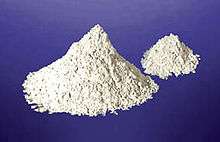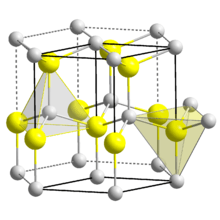Aluminium nitride
Aluminium nitride (AlN) is a solid nitride of aluminium. It has a high thermal conductivity of up to 285 W/(m·K), and is an electrical insulator. Its wurtzite phase (w-AlN) has a band gap of ~6 eV at room temperature and has a potential application in optoelectronics operating at deep ultraviolet frequencies.
 | |
 | |
| Names | |
|---|---|
| Other names
Aluminium nitride | |
| Identifiers | |
3D model (JSmol) |
|
| ChEBI | |
| ChemSpider | |
| ECHA InfoCard | 100.041.931 |
| EC Number |
|
PubChem CID |
|
| RTECS number |
|
| UNII | |
CompTox Dashboard (EPA) |
|
| |
| |
| Properties | |
| AlN | |
| Molar mass | 40.989 g/mol[1] |
| Appearance | white to pale-yellow solid |
| Density | 3.255 g/cm3[1] |
| Melting point | 2,500 °C (4,530 °F; 2,770 K)[2] |
| hydrolyses (powder), insoluble (monocrystalline) | |
| Solubility | insoluble, subject of hydrolysis in water solutions of bases and acids [3] |
| Band gap | 6.015 eV[4][5] (direct) |
| Electron mobility | ~300 cm2/(V·s) |
| Thermal conductivity | 285 W/(m·K)[6] |
Refractive index (nD) |
2.1–2.2 (crystals) 1.8-1.9 (amorphous)[6] |
| Structure[7] | |
| Wurtzite | |
| C6v4-P63mc, No. 186, hP4 | |
a = 0.31117 nm, c = 0.49788 nm | |
Formula units (Z) |
2 |
| Tetrahedral | |
| Thermochemistry[8] | |
Heat capacity (C) |
30.1 J/(mol·K) |
Std molar entropy (S |
20.2 J/(mol·K) |
Std enthalpy of formation (ΔfH⦵298) |
-318.0 kJ/mol |
Gibbs free energy (ΔfG˚) |
-287.0 kJ/mol |
| Hazards | |
| NFPA 704 (fire diamond) | |
Except where otherwise noted, data are given for materials in their standard state (at 25 °C [77 °F], 100 kPa). | |
| Infobox references | |
History and physical properties
AlN was first synthesized in 1877.
AlN, in the pure (undoped) state has an electrical conductivity of 10−11-10−13 Ω−1⋅cm−1, rising to 10−5-10−6 Ω−1⋅cm−1 when doped.[6] Electrical breakdown occurs at a field of 1.2–1.8×105 V/mm.[6] It is predicted that the cubic zinc blend phase of AlN (zb-AlN) can exhibit superconductivity at high pressures. [9]
AlN has high thermal conductivity, especially for an electrically insulating ceramic (70–210 W/(m·K) for polycrystalline material, and as high as 285 W/(m·K) for single crystals).[6]
Stability and chemical properties
Aluminium nitride is stable at high temperatures in inert atmospheres and melts about 2200 °C. In a vacuum, AlN decomposes at ~1800 °C. In the air, surface oxidation occurs above 700 °C, and even at room temperature, surface oxide layers of 5–10 nm thickness have been detected. This oxide layer protects the material up to 1370 °C. Above this temperature bulk oxidation occurs. Aluminium nitride is stable in hydrogen and carbon dioxide atmospheres up to 980 °C.[10]
The material dissolves slowly in mineral acids through grain boundary attack, and in strong alkalies through attack on the aluminium nitride grains. The material hydrolyzes slowly in water. Aluminium nitride is resistant to attack from most molten salts, including chlorides and cryolite.
Aluminium nitride can be patterned with a Cl2-based reactive ion etch.[11][12]
Manufacture
AlN is synthesized by the carbothermal reduction of aluminium oxide in the presence of gaseous nitrogen or ammonia or by direct nitridation of aluminium. The use of sintering aids, such as Y2O3 or CaO, and hot pressing is required to produce a dense technical grade material.
Applications
Epitaxially grown thin film crystalline aluminium nitride is used for surface acoustic wave sensors (SAWs) deposited on silicon wafers because of AlN's piezoelectric properties. One application is an RF filter which is widely used in mobile phones,[13] which is called a thin film bulk acoustic resonator (FBAR). This is a MEMS device that uses aluminium nitride sandwiched between two metal layers.[14]
AlN is also used to build piezoelectric micromachined ultrasound transducers, which emit and receive ultrasound and which can be used for in-air rangefinding over distances of up to a meter.[15][16]
Metallization methods are available to allow AlN to be used in electronics applications similar to those of alumina and beryllium oxide. AlN nanotubes as inorganic quasi-one-dimensional nanotubes, which are isoelectronic with carbon nanotubes, have been suggested as chemical sensors for toxic gases.[17][18]
Currently there is much research into developing light-emitting diodes to operate in the ultraviolet using gallium nitride based semiconductors and, using the alloy aluminium gallium nitride, wavelengths as short as 250 nm have been achieved. In 2006, an inefficient AlN LED emission at 210 nm was reported.[19]
Among the applications of AlN are
- opto-electronics,
- dielectric layers in optical storage media,
- electronic substrates, chip carriers where high thermal conductivity is essential,
- military applications,
- as a crucible to grow crystals of gallium arsenide,
- steel and semiconductor manufacturing.
See also
References
- Haynes, p. 4.45
- Haynes, p. 12.80
- Fukumoto, S.; Hookabe, T.; Tsubakino, H. (2010). "Hydrolysis behavior of aluminum nitride in various solutions". J. Mat. Science. 35 (11): 2743–2748. doi:10.1023/A:1004718329003.
- Haynes, p. 12.85
- Feneberg, M.; Leute, R. A. R.; Neuschl, B.; Thonke, K.; Bickermann, M. (2010). Phys. Rev. B. 82 (7): 075208. Bibcode:2010PhRvB..82g5208F. doi:10.1103/physrevb.82.075208.CS1 maint: untitled periodical (link)
- "AlN – Aluminium Nitride". Ioffe Database. Sankt-Peterburg: FTI im. A. F. Ioffe, RAN. Retrieved 2014-01-01.
- Vandamme, Nobuko S.; Richard, Sarah M.; Winzer, Stephen R. (1989). "Liquid-Phase Sintering of Aluminum Nitride by Europium Oxide Additives". Journal of the American Ceramic Society. 72 (8): 1409–1414. doi:10.1111/j.1151-2916.1989.tb07662.x.
- Haynes, p. 5.4
- Dancy, G. Selva; Sheeba, V. Benaline; Louis, C. Nirmala; Amalraj, A. (2015-09-30). "Superconductivity in Group III-V Semiconductor AlN Under High Pressure". Orbital - the Electronic Journal of Chemistry. Instituto de Quimica - Univ. Federal do Mato Grosso do Sul. 7 (3). doi:10.17807/orbital.v7i3.628. ISSN 1984-6428.CS1 maint: ref=harv (link)
- Berger, L. I. (1997). Semiconductor Materials. CRC Press. pp. 123–124. ISBN 978-0-8493-8912-2.
- Chih-ming Lin; Ting-ta Yen; Yun-ju Lai; Felmetsger, V.V.; Hopcroft, M.A.; Kuypers, J.H.; Pisano, A.P. (March 2010). "Temperature-compensated aluminum nitride lamb wave resonators". IEEE Transactions on Ultrasonics, Ferroelectrics and Frequency Control. 57 (3): 524–532. doi:10.1109/TUFFC.2010.1443. PMID 20211766.
- Xiong, Chi; Pernice, Wolfram H. P.; Sun, Xiankai; Schuck, Carsten; Fong, King Y.; Tang, Hong X. (2012). "Aluminum nitride as a new material for chip-scale optomechanics and nonlinear optics". New Journal of Physics. 14 (9): 095014. arXiv:1210.0975. Bibcode:2012NJPh...14i5014X. doi:10.1088/1367-2630/14/9/095014. ISSN 1367-2630.
- Tsuruoka, Doug (2014-03-17). "Apple, Samsung Cellphone Filter Orders Lift Avago". news.investors.com.
- "ACPF-7001: Agilent Technologies Announces FBAR Filter for U.S. PCS Band Mobile Phones and Data Cards". wirelessZONE. EN-Genius Network Ltd. 2002-05-27. Retrieved 2008-10-18.
- "A Gestural Interface for Smart Watches".
- Przybyla, R.; al, et (2014). "3D Ultrasonic Gesture Recognition". International Solid State Circuits Conference. San Francisco. pp. 210–211.
- Ahmadi, A; Hadipour, NL; Kamfiroozi, M; Bagheri, Z (2012). "Theoretical study of aluminium nitride nanotubes for chemical sensing of formaldehyde". Sensors and Actuators B: Chemical. 161 (1): 1025–1029. doi:10.1016/j.snb.2011.12.001.
- Ahmadi Peyghan, A; Omidvar, A; Hadipour, NL; Bagheri, Z; Kamfiroozi, M (2012). "Can aluminum nitride nanotubes detect the toxic NH3 molecules?". Physica E. 44 (7–8): 1357–1360. Bibcode:2012PhyE...44.1357A. doi:10.1016/j.physe.2012.02.018.
- Taniyasu, Y.; et al. (2006). "An Aluminium Nitride Light-Emitting Diode with a Wavelength of 210 Nanometres". Nature. 441 (7091): 325–328. Bibcode:2006Natur.441..325T. doi:10.1038/nature04760. PMID 16710416.
Cited sources
- Haynes, William M., ed. (2016). CRC Handbook of Chemistry and Physics (97th ed.). CRC Press. p. 4.45. ISBN 9781498754293.
| NH3 N2H4 |
He(N2)11 | ||||||||||||||||
| Li3N | Be3N2 | BN | β-C3N4 g-C3N4 CxNy |
N2 | NxOy | NF3 | Ne | ||||||||||
| Na3N | Mg3N2 | AlN | Si3N4 | PN P3N5 |
SxNy SN S4N4 |
NCl3 | Ar | ||||||||||
| K3N | Ca3N2 | ScN | TiN | VN | CrN Cr2N |
MnxNy | FexNy | CoN | Ni3N | CuN | Zn3N2 | GaN | Ge3N4 | As | Se | NBr3 | Kr |
| Rb3N | Sr3N2 | YN | ZrN | NbN | β-Mo2N | Tc | Ru | Rh | PdN | Ag3N | CdN | InN | Sn | Sb | Te | NI3 | Xe |
| Cs3N | Ba3N2 | Hf3N4 | TaN | WN | Re | Os | Ir | Pt | Au | Hg3N2 | TlN | Pb | BiN | Po | At | Rn | |
| Fr3N | Ra3N2 | Rf | Db | Sg | Bh | Hs | Mt | Ds | Rg | Cn | Nh | Fl | Mc | Lv | Ts | Og | |
| ↓ | |||||||||||||||||
| La | CeN | Pr | Nd | Pm | Sm | Eu | GdN | Tb | Dy | Ho | Er | Tm | Yb | Lu | |||
| Ac | Th | Pa | UN | Np | Pu | Am | Cm | Bk | Cf | Es | Fm | Md | No | Lr | |||
